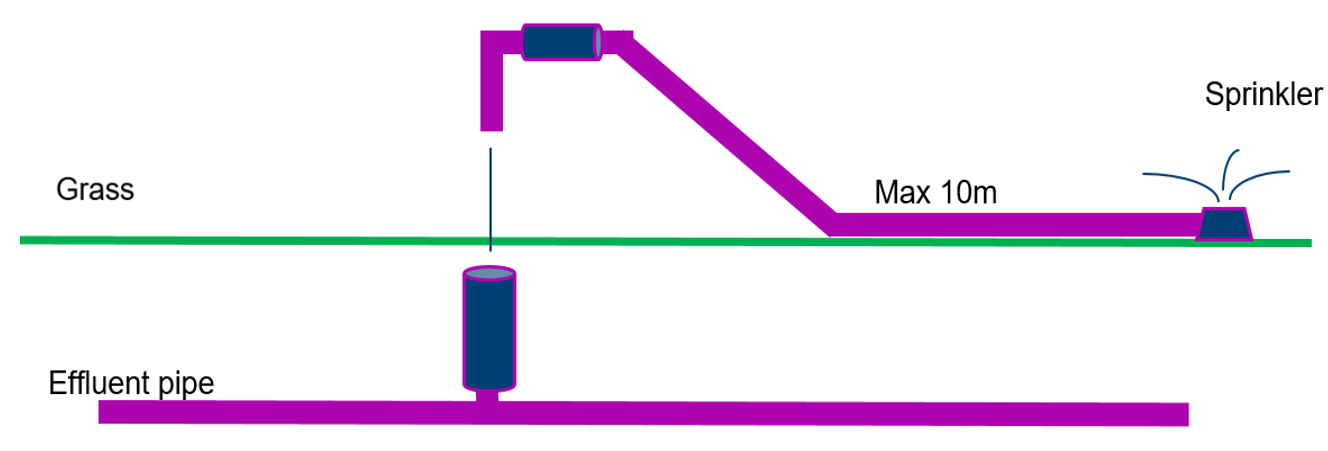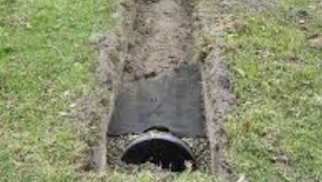On-site sewerage facilities
If your property does connect to our sewer system you will need on-site facilities to store, treat and dispose of your household wastewater and sewage.
Types of on-site sewerage facilities include:
- Septic system – treats waste biologically and discharges below-ground. Common on older properties.
- On-site sewage treatment system – treats waste using mechanical, biological and filtration methods and discharges above ground or through below-ground irrigation systems.
Your facility:
- may include one or more of these systems
- must be located within your property boundary
- must be located within the land application area (LAA) for your sewerage facility (this is the section of land used to dispose of treated wastewater).
How these systems work
On-site sewerage facilities use a series of chambers and tanks to treat sewage, separating effluent from waste.
Waste separation process
- Larger solids settle in the main tank (sludge) while remaining fluids float (scum).
- Water that has been partly clarified flows into a second chamber. Here it mixes with air, promoting the bacterial breakdown of organic matter.
- In remaining chambers, solids settle further. The system disinfects these using ultraviolet light or a chemical like chlorine.
- Liquid that remains is called effluent. Compared to raw waste, it contains much lower levels of nutrients, pollutants and pathogens that cause disease.
- Effluent is then released into the soil, where it breaks down.
How effluent is disposed
Effluent disposal must take place:
- on the property where it is located
- only within an approved land application area (LAA)
- through surface irrigation (sprinklers) or underground (subsurface) systems.
Note: During wet season the LAA can become saturated and may reduce the efficiency of the system. Please contact your supplier to discuss options.
Above ground disposal (surface irrigation)
An above ground disposal system disposes effluent above the surface of the ground within the land application area. It may use a network of drip, trickle or sprinkler dispersion points that can be moved.
Requirements include:
- Sprinklers must produce heavy droplets rather than a spray or mist.
- Effluent must not pond or create runoff.
- You must move the dispersion points often.
- You cannot move dispersion points outside the land application area.
- You must not extend the dispersion hose without design approval.

Diagram showing the setup of surface irrigation with an underground effluent pipe pumping up on top of the grass, through a pipe no longer than 10 metres connected to a sprinkler that disperses effluent.
Underground disposal (subsurface irrigation)
Disposal systems may also use an absorption trench or mound. This allows effluent to seep into the ground beneath the surface layer.

Maintenance and care
Maintaining your system is essential. Under Queensland law you must:
- service an aerobic wastewater treatment plant every 3 months
- service an aerobic sand filter treatment system every year
- have a licensed service agent carry out the maintenance service
- keep a copy of the report provided by the licensed service agent to Council.
Licensed service agents
Different systems will need different approaches to care and maintenance.
Usually, a licensed service agent will:
- maintain mechanical equipment
- check accumulated sludge levels
- check irrigation system operation
- add chlorine and check operation of the disinfection system
- remove sludge and scum from the clarifier (final chamber)
- provide a copy of the service report to Council.
To access your sewerage system’s service history and manufacturer information, use our on-site sewage facility identification service.
Chemicals and household products
Take care to avoid using household products that interfere with the performance of your sewerage system. Detergents and chemicals can kill vital bacteria. Without enough bacteria, your tank may not digest effluent, causing odour. If you are unsure what to use, ask your service agent or contact us.
Common issues
Unmaintained tanks can lead to a costly system failure.
- Mechanical components like blowers and pumps can fail. This causes tank levels to rise and leak from the lid, creating unhealthy conditions and an unpleasant odour.
- Particle build-up can clog sprinkler heads.
- Tree roots or crushed pipes, from heavy traffic, can also clog subsurface systems.
- Load on your system will also increase if:
- your taps leak
- you use excessive water
- you have more people live in your home.
Tips for success
Use natural cleaning products and low phosphorous detergents in your home.
- Avoid solvents, oils, paints, disinfectants, pesticides, household cleaning products and bleaches.
- Make sure your existing house drainage system is in good order and is free from broken pipes or leaks.
- Engage a licensed service agent to conduct quarterly repairs and proactive maintenance.
- De-sludge tanks, pumps and drainage lines regularly.
- Maintain and protect your land application area.
- Ensure you receive quarterly copies of service maintenance reports and comply with the
- Plumbing and Drainage Act 2018
- Plumbing and Drainage Regulation 2019.
Land application area (LAA)
A land application area maps out:
- the layout of the property and treatment facility, including the area for effluent disposal
- location of existing and proposed buildings
- proximity to waterways and stormwater corridors
- setbacks from property lines, buildings and waterways.

Example map of a Land application area showing layout of the property, including a treatment plant, with pipes that connect to a Land application area containing a stormwater diversion mound, where surface irrigation takes place.
Effluent you dispose in this area contains nutrients, pollutants and pathogens that cause disease. Although the soil will break these down, please make sure you:
- do not use the land application area (LAA) for recreation, growing edible plants, keeping pets or for children’s play
- do not extend your hose outside of the LAA
- maintain surrounding plants and mow grass within the LAA to support evaporation and effluent breakdown in the soil.
To avoid disrupting a land application area:
- do not drive on or disturb storm water diversion mounds
- do not build structures, pathways or plant trees that will cover or shade the area
- avoid flooding the disposal area with sprinklers or hoses, or adding extra soil to the area which may cause it to become saturated
- avoid storing earth material / soils on the disposal area for later use.
Request approval for on-site sewerage facility
You will need Council approval to install or make changes to an on-site sewerage treatment facility or grey water facility. To apply, please see Plumbing and drainage application forms and lodgment.
You can find a list of approved sewerage systems and facilities on the Business Queensland website.
Report non-compliant sewerage systems
To report any possible non-compliant sewerage systems, please call us on 07 3412 3412.
We will investigate the issue and contact you with the outcome of our investigation.
Find out more
For more information, lodge a request online or call us on 3412 3412.